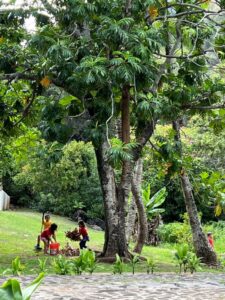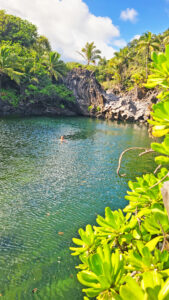A simple garden not so simple, Lanai study finds
A lack of space and time lead to more ‘Americanized’ diet, less ethnic cuisine
Jomel Etrata’s family has something that many others on Lanai wish they had — a backyard garden.
It’s a simple thing, but many people don’t have the time or the space to do it, which means they often end up relying on store-bought foods. That’s one of the many things Etrata and 21 other high school students discovered during a recent study of Lanai’s food system.
The students hope the community food assessment, published this month in the “Hawaii Journal of Medicine and Public Health,” will help spur a conversation about food and health on Lanai, and create changes that will help the island be more self-reliant.
“It gives us a huge insight on what our community members want and better understand how us Lanai residents feel about the food we’re putting on the table and how it will affect our own families,” said Etrata, a 17-year-old senior at Lanai High and Elementary School.
During Etrata’s sophomore year, students were studying different food-related topics, such as urban gardening. The projects generated interest in answering a broader question — how does what we eat affect who we are, how we feel and what we hope to become?
English teacher Karen de Brum recruited the help of food law expert and lawyer A-dae Romero-Briones, a former Pulama Lana’i employee and current director of programs for native agriculture and food systems at the First Nations Development Institute. Romero-Briones helped the students conduct a pilot assessment of 200 mostly high school and middle school students. There was interest in the topic, so the students went deeper — to get the perspectives of the people making decisions about what to buy and eat in their homes.
During the 2017-18 school year, students collected 656 surveys from a population of about 2,200 adults. They held focus groups to interview 43 adults, particularly kupuna, about food, culture and health.
“The students were as successful as they were because the community really dug in and supported this project,” de Brum said. “Very few people said they weren’t interested.”
What the students found was symptomatic of Hawaii’s overall problem of sustainability — people want more cultural foods and locally-grown produce, but costs, land access and the relative ease of cooking pre-packaged foods stand in the way.
On an island where milk can go for $8 a gallon, most Lanai residents in the study said they go off island to stock up on produce and meat, as well as healthier, organic and cultural foods. Not only does that mean hundreds of dollars being spent off island, but “there is a lost opportunity when it comes to providing island produce,” the study said.
Residents said they wanted to eat more island-grown produce, but that it wasn’t affordable. And, while they expressed interest in growing their own food, they also said they had neither the time nor the space to do it.
“I was very surprised at how strong the voice was in the report,” de Brum said. “People were pretty much in agreement that they would like to see more produce grown locally. The reliance on the barge is becoming a concern.”
Residents recalled the plantation days when many families had small gardens and relied on local and cultural foods. But with families working night shifts and split shifts, many said the quicker, store-bought meals are an easier option. They worried that the shift from cultural to imported foods would not only impact their health — 66.2 percent of Lanai residents report being either obese or overweight, according to the Behavioral Risk Factor Surveillance System — but their identity as well.
“On the food and cultural side, most people are becoming more Americanized, and they aren’t eating foods that come from their cultural background,” Etrata said.
“Our new generation is eating foods that aren’t what their parents used to eat, so it’s not really passing down the culture and not really keeping that tradition.”
In his own home, Etrata said his family eats a mix of Filipino and “Americanized” foods. The family grows fruits and vegetables in its garden, and Etrata’s father also goes fishing. He said the family goes off island a couple times a year to stock up on other goods.
Feeding the community through fishing and hunting was “a clear source of pride and identity on the island,” the study found. Residents pointed to “an active and enthusiastic” community of hunters and fishermen who bring home meat for their families and friends and use it to trade for other goods.
De Brum said her husband goes fishing and will sometimes trade his catch for locally grown vegetables. She said she buys most raw ingredients at the store, but is among those who would happily pay a little more to support local produce growers.
In May, the students reported their findings to the local community and later to Pulama Lana’i. De Brum said the goals of the food assessment were threefold — to create a discussion, give a voice to residents’ relationship to food and help people make informed decisions about food in the future. She said the study “has given us a picture of where we are now.”
“I really would like it to be a community next step,” de Brum said. “This year, for my students, I would like for them to be listening . . . to what people are saying about the data and put together action steps. I don’t want to chart the next steps myself. I want to hear. I want to listen.”
Etrata said he’d like to see “people being more independent in their own food habits and growing their food, starting their own garden.”
“We rely on the barge a lot,” he said. “I’d like to see people be more food independent.”
* Colleen Uechi can be reached at cuechi@mauinews.com.
- Morgan Jonas, then a junior at Lanai High, interviews a kupuna during an islandwide community food assessment on Lanai during the 2017-18 school year. Students collected surveys from 656 adults to understand how Lanai’s food system and access to certain products impact the health and identity of island residents. — Lanai High and Elementary School photo
- Students conduct a focus group as part of the community food assessment. The students moderated 14 separate focus groups and interviewed 43 adults in the community. — Lanai High and Elementary School photo







